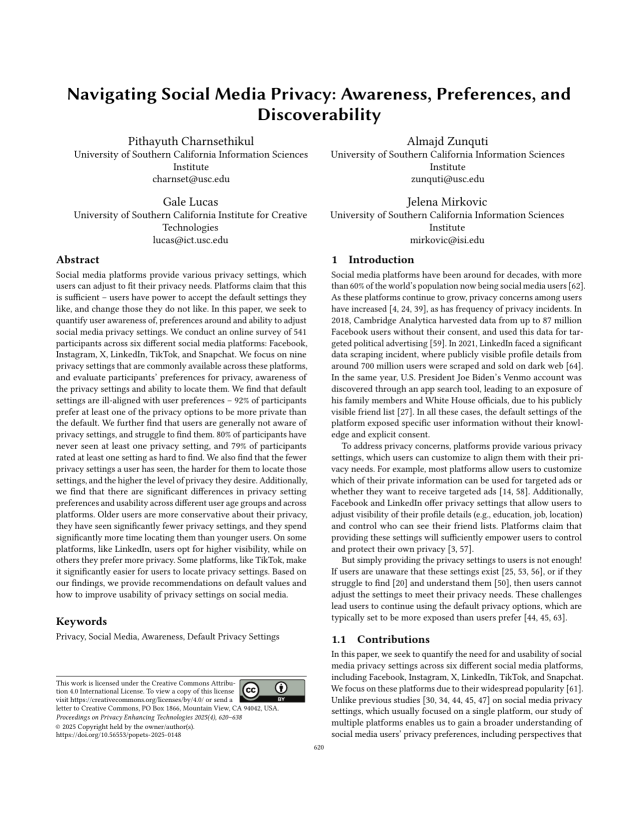Navigating Social Media Privacy: Awareness, Preferences, and Discoverability
Authors: Pithayuth Charnsethikul (University of Southern California Information Sciences Institute), Almajd Zunquti (University of Southern California Information Sciences Institute), Gale Lucas (University of Southern California Institute for Creative Technologies), Jelena Mirkovic (University of Southern California Information Sciences Institute)
Volume: 2025
Issue: 4
Pages: 620–638
DOI: https://doi.org/10.56553/popets-2025-0148
Artifact: Available, Functional, Reproduced
Abstract: Social media platforms provide various privacy settings, which users can adjust to fit their privacy needs. Platforms claim that this is sufficient – users have power to accept the default settings they like, and change those they do not like. In this paper, we seek to quantify user awareness of, preferences around and ability to adjust social media privacy settings. We conduct an online survey of 541 participants across six different social media platforms: Facebook, Instagram, X, LinkedIn, TikTok, and Snapchat. We focus on nine privacy settings that are commonly available across these platforms, and evaluate participants’ preferences for privacy, awareness of the privacy settings and ability to locate them. We find that default settings are ill-aligned with user preferences – 92% of participants prefer at least one of the privacy options to be more private than the default. We further find that users are generally not aware of privacy settings, and struggle to find them. 80% of participants have never seen at least one privacy setting, and 79% of participants rated at least one setting as hard to find. We also find that the fewer privacy settings a user has seen, the harder for them to locate those settings, and the higher the level of privacy they desire. Additionally, we find that there are significant differences in privacy setting preferences and usability across different user age groups and across platforms. Older users are more conservative about their privacy, they have seen significantly fewer privacy settings, and they spend significantly more time locating them than younger users. On some platforms, like LinkedIn, users opt for higher visibility, while on others they prefer more privacy. Some platforms, like TikTok, make it significantly easier for users to locate privacy settings. Based on our findings, we provide recommendations on default values and how to improve usability of privacy settings on social media.
Keywords: Privacy, Social Media, Awareness, Default Privacy Settings
Copyright in PoPETs articles are held by their authors. This article is published under a Creative Commons Attribution 4.0 license.

